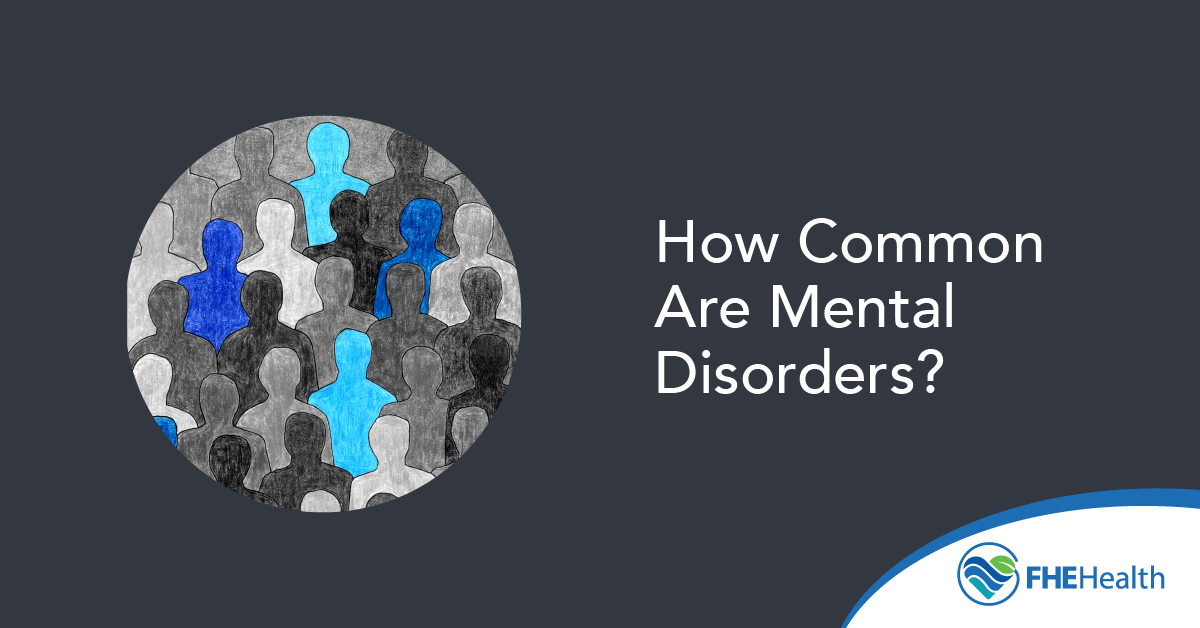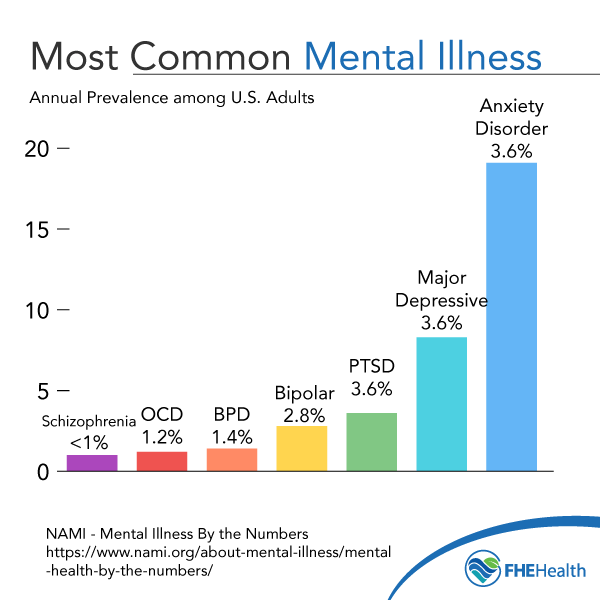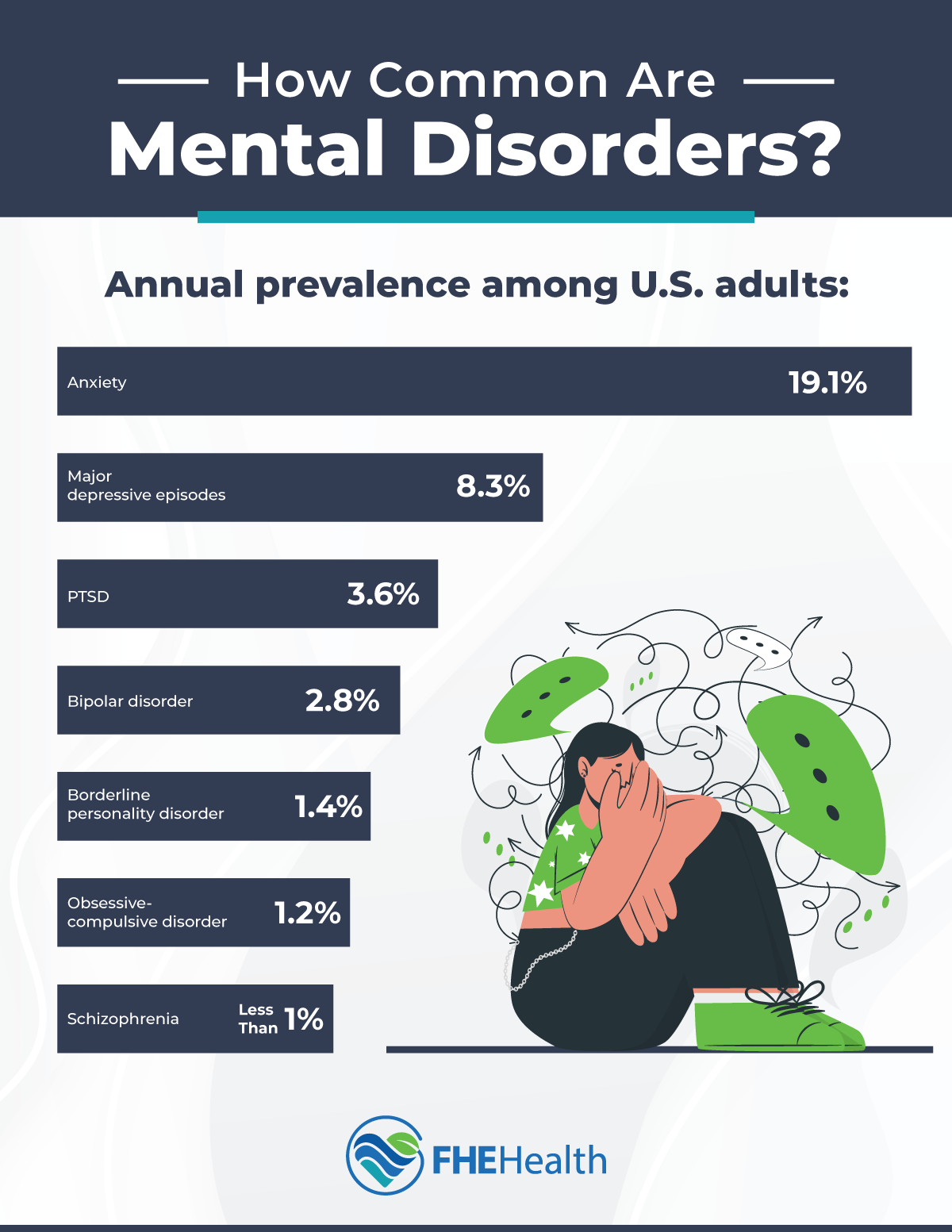
In 2021, 22.8% of American adults experienced some form of mental illness. Anxiety is the most common mental illness, with major depressive episodes and post-traumatic stress disorder coming in second and third. As the United States observes Mental Health Awareness Month, learning about disorders and eliminating the stigma could help millions of people receive care.
Just How Common Is Mental Illness?
With nearly 1 in 5 adults in the United States experiencing a mental illness, it’s important for people to recognize that they’re not alone. Millions of young people also suffer from mental disorders, with suicide becoming one of the leading causes of death for people aged 10 to 14. About half of all mental illnesses start showing symptoms by age 14.
LGBT people are particularly susceptible, with 50.2% of individuals experiencing a mental disorder. Almost 35% of mixed-race people suffer from a disorder, while 26.6% of Native Americans report symptoms of mental illness. In 2021, 7.6% of adults dealt with substance abuse alongside a mental issue.
What Is the Most Common Mental Illness?
The National Alliance on Mental Illness reports these percentages among U.S. adults.
- Anxiety: 19.1%
- Major depressive episodes: 8.3%
- PTSD: 3.6%
- Bipolar disorder: 2.8%
- Borderline personality disorder: 1.4%
- Obsessive-compulsive disorder: 1.2%
- Schizophrenia: Less than 1%
These findings show that social anxiety, phobias, generalized anxiety disorder and similar issues are among the most common mental disorders.
What Is the Difference Between Mental Illness, Disorder and Health?
It’s common for these terms to be used interchangeably, but they’re a bit different. Mental health is often used to discuss the mental well-being of a person. This includes emotions, thoughts and feelings. Mental illness, on the other hand, is a change within the brain’s chemistry that affects the way people think or behave. A mental disorder is an underlying condition that causes this to occur.
Types of Mental Illness
Every mental illness has its own symptoms. However, they can impact anyone anywhere. Some of the most common mental disorders include:
- Anxiety disorders involve a persistent and excessive amount of worry or fear over situations that aren’t threatening. They feel jumpy, restless and apprehensive about day-to-day life.
- Bipolar disorder can be harder to pinpoint, as some people go years without any symptoms. Yet individuals who live with this condition have manic and depressive states. They may also have hallucinations or delusions.
- Depression, a life-threatening condition, is one in which a person is unable to move past feeling sad and hopeless. They tend to have changes in sleep and eating patterns. They lack concentration abilities and interest in things they used to love.
- Obsessive-compulsive disorder occurs when an individual has intrusive thought patterns that tend to be irrational and create excessive urges. These compulsions may involve harming others.
- Post-traumatic stress disorder often occurs when an individual has experienced some type of traumatic or violent event in which they feared for their life. Symptoms include replaying those events, unnatural fears and the inability to focus.
- Dissociative disorders often occur after a traumatic or very stressful event. Individuals suffer from a disconnection between their identity, thoughts or consciousness. Their memory may fade and improve.
- Attention deficit hyperactivity disorder is a type of developmental disorder that can make it hard for an individual to focus or pay attention to what’s happening due to an impulse to do something or move.
There are many other mental illnesses. These include autism, borderline personality disorder, psychosis, eating disorders and schizoaffective disorder. Each one requires mental health treatment to be fully understood. Individuals may not recognize the symptoms or signs of mental illness in themselves. However, families can often spot changes in personality, actions and awareness that can provide indications.
How Can You Reduce the Stigma?
Plenty of stigmas surround common mental disorders. Society often dismisses mentally ill people as “crazy,” “lazy,” or “beyond help.” If you seek therapy, people could say that you’re “admitting you’re crazy” or refuse to “tough it out.” These barriers make it harder for people to seek help, recover and enjoy happier lives.
You can challenge the stigma by seeking help. Going to therapy normalizes this behavior, encouraging the people around you to get help for their disorders. You could also spread awareness about common mental disorders online by sharing posts from reputable sources and talking about your own experiences. When someone criticizes others for discussing their disorders, encourage them to challenge their thinking.
You Can Get Help for Mental Illness
Whether you or a loved one is suffering from mental illness, help is available. Our programs include a full diagnosis and individual treatment plans to help you succeed. Contact us for one-on-one treatment and care.








